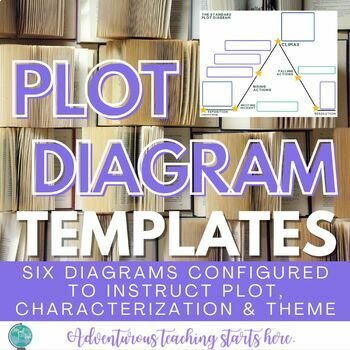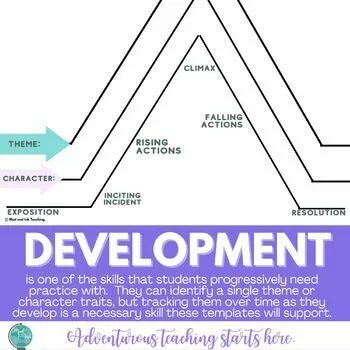Unit Makeover: The Short Story Unit in Secondary ELA
Unit Makeover: The Short Story Unit in Secondary ELA
When is the last time you sat down for a meal where your server recommended a very specific bottle of wine to match the meal you were considering on the menu? The perfect Argentinian Malbec to compliment the perfect marbled ribeye. And when is the last time you tasted that symphony of flavors? The melting, fatty salt of the meat on your tongue is followed by the gentle swirl of the deep red wine just after.
Maybe you’re a vegetarian and ready to never come back here and read another article from me again, and I understand (this is not the first time that I’ve used a metaphor about meat. Hmmm…), but if you’re willing to hear me out, here it is:
Disjointed experiences are fine, but intentionally, purposefully blended ones are so much more memorable.
This is precisely how I feel about unit planning and especially the notoriously predictable plan that every English teacher since the dawn of time seems to design: UNIT 1 - SHORT STORIES.
THE DISJOINTED SHORT STORY SCENARIO
The idea for this unit seems logical on paper: start the year with some shorter texts to warm back up, review everything students need to know for the year coming up, and presto! Ready to take on the year. But after experiencing this myself and talking to hundreds of other teachers, there are a few notable problems:
PROBLEM 1: Lack of connection
Short stories don’t naturally connect to one another just because they are short stories. So when we begin these units thinking about the skill review component, we are often blindsided as the unit is in progress feeling like it’s clunky and lacks flow. Without the feeling of connection, these units can be difficult to navigate in terms of pacing and engagement.
PROBLEM 2: Lack of representation
The most commonly anthologized stores also tend to be Euro-centric, male-authored stories. We have a responsibility to do better for our students and to have their own voices, stories, backgrounds, and experiences represented and included in everything we do. This means branching outside of the short stories most frequently recommended by text book companies and doing some of our own research to find new, fresh voices.
PROBLEM 3: Lack of variety
One teacher wrote to me saying: “I do run into trouble when I try to use short stories that are available on CommonLit. When I've tried to use them in the past--some are amazing short stories, like "The Landlady" and "The Intepolers"--the kids complain that they've already read them! UGH”
Does this sound familiar? Since starting the year this way is so popular and databases like CommonLit have come around, teachers sometimes find themselves going to the same places for ideas and then repeating stories.
PROBLEM 4: Trying to cover too many skills
Sometimes the nebulous goal of “reviewing literary terms” stretches student focus too thin. Attempting to use one single unit to cover a dozen or more terms ends up giving us more attention to breadth rather than depth.
Specific EQ Unit & Text Set Pairings:
To solve many of these problems with the traditional short story unit, I recommend implementing an Essential Question to drive the unit. Short stories need to be contextualized, and using an Essential Question connects the dots and creates meaning. The art of writing an essential question takes into consideration three key components: text(s), themes, and skills. Essential questions should drive genuine curiosity and be exciting for students to explore, discuss, debate, and return to throughout the year.
Below, I’ve drafted a few examples of EQs that could theoretically be used at the start of a school year. You’ll notice a few things:
The question anchors the unit. From introducing the question to assessment, the question is the driving force that connects all texts and activities.
Instead of teaching short stories and a variety of random literary terms, the unit is cohesively driven by a more narrow focus.
The EQ gives direction for the unit without being prescriptive. The suggestions I have here are flexible and adaptable to different grade and difficulty levels.
In each of the example units below, I’ve provided a mixture of the most commonly used short stories that you may have from anthologies or prescription curriculums blended with new ideas, short film, music, and other genres to further address the complexity of the EQ. Be sure to check out Episode 107 of the Brave New Teaching Podcast to see how this method was applied in Marie’s class!
Here are a few example ideas to get started:
Example #1: Connected by a skill/standard
Unit 1: Is conflict more likely to make our lives better or worse?
Skill Focus: The shape and arc of stories
Plot diagram components (with emphasis on conflict)
Exposition, inciting incident, rising actions, climax, falling actions, resolution
Vonnegut’s The Shape of Stories
Internal VS External Conflict
Three classical types of conflict: “man vs man”, “man vs. nature”, “man vs himself”
Text Set:
Buzz Lightyear Internal Conflict - You are Just a Toy: Scene 1 & Scene 2
All American on Netflix Episode 1
Assessment:
Skill Focus: Cold Read & Written response based on conflict
EQ Focus: Synthesis argument writing answering the EQ (utilize personal experience and texts from the unit to answer EQ)
Example #2: Connected by genre
Unit 1: To what extent does gothic fiction reveal the human condition?
Skill Focus: The elements of gothic fiction
Author’s use of tension
Author’s use of tone/mood
Setting
Text Set:
Excerpt from Mexican Gothic by Sylvia Moreno Garcia
Various scenes from The Phantom of the Opera
Assessment:
Skill Focus: A project-based assignment where students analyze the connection between tension, mood and setting (a recreated scene and written analysis; a living tableau; an artistic interpretation)
EQ Focus: A literary analysis writing that hones in on one of the stories and the gothic elements that reveal the human condition
Need to teach plot elements?
Example #3: Connected by another genre
Unit 1: How does dystopian fiction use the present to predict the dangers of the future?
Skill Focus: The elements of dystopian fiction
Characteristics of a dystopian protagonist
Author’s use of tone/mood
Setting
Imagery
Text Set:
“There Will Come Soft Rains” by Ray Bradbury
“The Lottery” by Shirley Jackson
“Harrison Bergeron” by Kurt Vonnegut
“The Ones Who Walk Away from Omelas” by Ursula K. LeGuin
Assessment:
Skill Focus: Cold Read & Write: How does the author’s use of genre elements / setting / imagery / use of tone/mood in order to warn about the dangers of the future?
EQ Focus: Research project: select a present problem and predict the dystopian future to come from this issue
Example #4: Connected by a theme
Unit 1: Which is more impactful in a child’s coming of age: the influence of family or the physical environment around them?
Skill Focus: Elements of coming of age genre
Setting
Characterization (direct & indirect)
Text Set:
Assessment:
Skill Focus: One Pager - Choose one character to place at the center. Surrounding the character, add evidence of coming-of-age moments, setting, etc. that have influenced their development
EQ Focus: Synthesis Argumentative essay responding to the EQ using the short stories from the unit
Example #5: Short Stories Reimagined in Fairy Tales
In episode 107 of the Brave New Teaching Podcast, I chat with my cohost Marie Morris about the process of tackling a unit makeover with short stories. Listen in to see how we resolved so many of the problems (at the top of this post) and built a Fairy Tale Unit that completely revamped the level of engagement while still tackling all of the skills that mattered the most.
No matter how you tackle your unit makeover, consider the power of that Essential Question to give the context your unit needs. I’d love to hear how you tackled your own makeover, so be sure to leave a comment below!
TRY AN EQ ADVENTURE PACK!
These units are packed up and ready to teach! They are seamlessly aligned with a juicy Essential Question, supplemental texts, and plenty of templates to use in tandem with whatever short stories or novels you have on hand. Check them out right here!


































